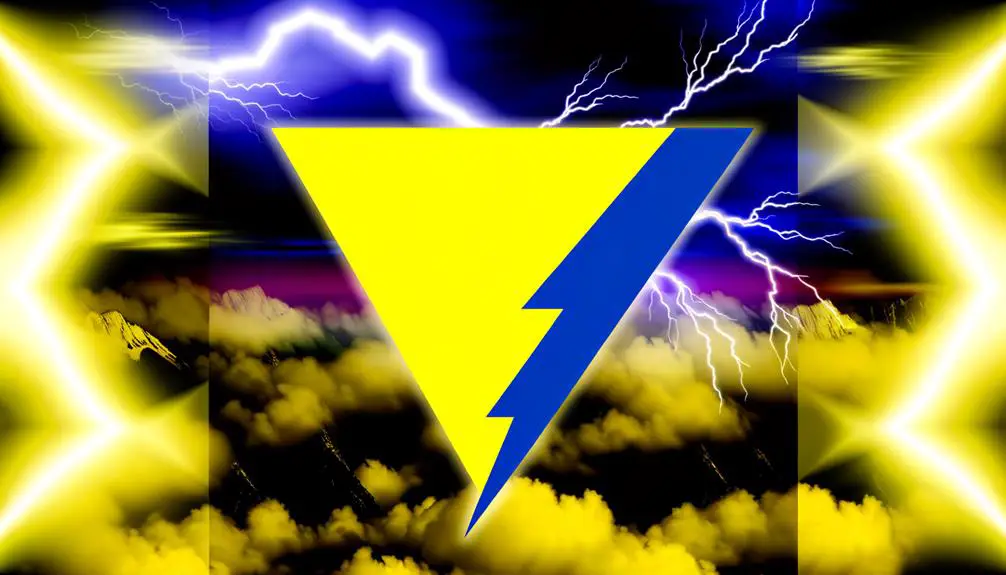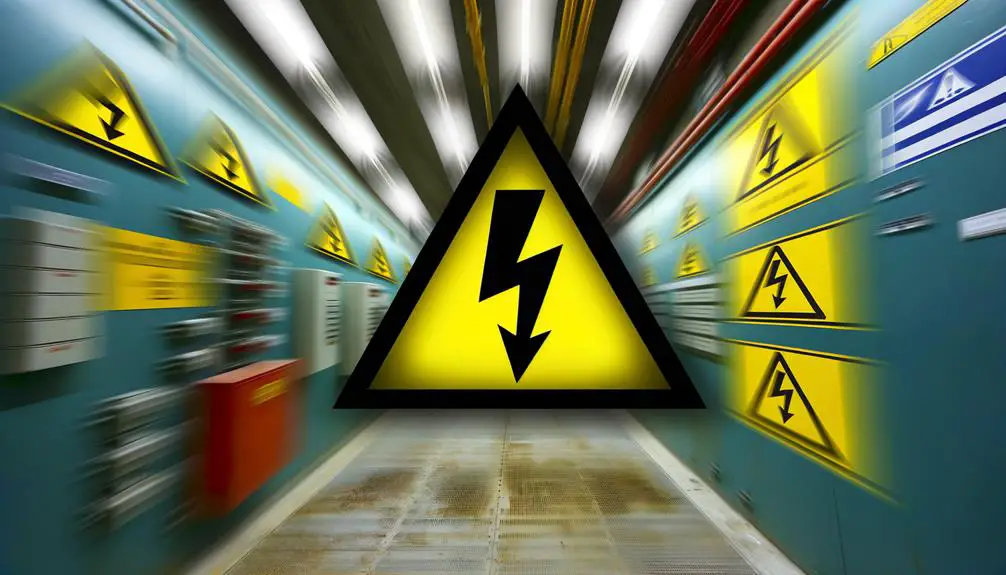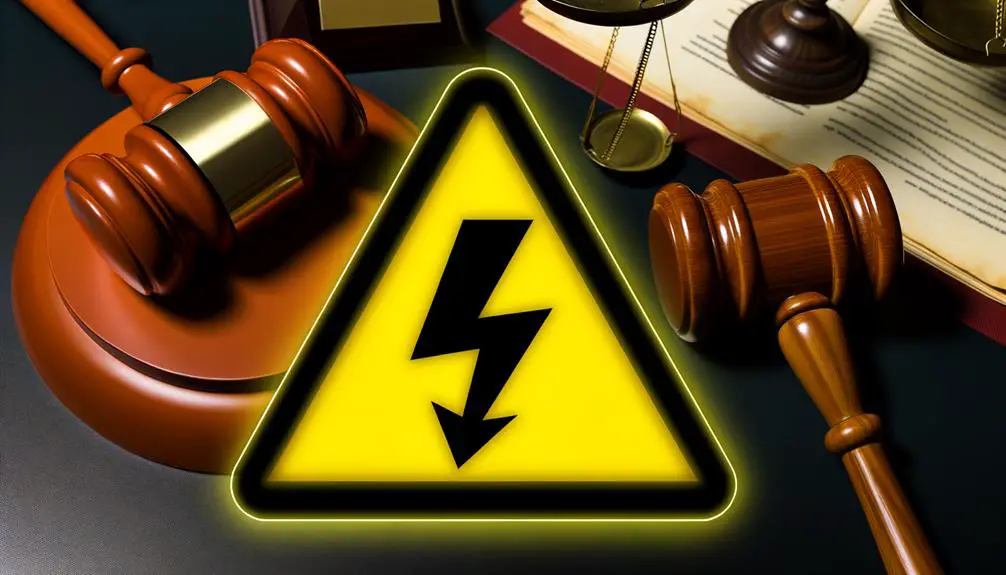Triangle Lightning Bolt Symbol: What Is Its Meaning?
The triangle with a lightning bolt symbol is a universally recognized warning sign indicating electrical hazards and high-voltage dangers. Originating in the early 20th century, its design effectively combines an equilateral triangle for stability and caution with a lightning bolt symbolizing sudden electrical danger.
The use of high-contrast colors and bold, simple lines ensures prompt recognition. This symbol is vital for safety compliance in industrial settings and is governed by international standards such as those from OSHA and IEC.
It is essential in preventing electrical accidents by clearly communicating potential risks. For a deeper understanding of its significance and regulatory implications, continue below.

Key Takeaways
- The triangle with a lightning bolt indicates an electrical hazard or high voltage danger.
- It's a universal safety symbol designed to prevent electrical accidents.
- The symbol combines an equilateral triangle for caution with a lightning bolt for sudden electrical danger.
- High-contrast colors and bold lines ensure quick recognition and visibility.
- Compliance with this symbol is governed by international and national safety standards.
Symbol Origins

The origins of the triangle with a lightning bolt symbol can be traced back to early electrical engineering and safety standards designed to warn individuals of high voltage hazards. This symbol emerged during the late 19th and early 20th centuries, coinciding with the advent of widespread electricity usage.
Regulatory bodies and industry groups recognized the need for a universally understood warning sign to mitigate the risks associated with electrical installations. Consequently, the triangle, signifying caution, combined with the lightning bolt, representing electricity, became an effective graphical representation.
This symbol's adoption was further solidified through its inclusion in various national and international standards, ensuring its recognition and adherence across different regions and industries.
Design Elements
Building on its historical origins, the triangle with a lightning bolt symbol incorporates specific design elements that enhance its effectiveness as a warning sign.
The equilateral triangle, universally recognized for stability and caution, provides a clear visual boundary. The lightning bolt, representing sudden electrical danger, is centrally positioned to draw immediate attention.
The use of high-contrast colors, typically black on yellow, guarantees visibility under various lighting conditions. Additionally, the bold, simple lines of the symbol facilitate quick recognition, even from a distance.
These design choices collectively secure the symbol's capacity to convey urgent caution, making it an integral part of safety protocols in environments with electrical hazards. The standardization across industries further strengthens its role in accident prevention.
Historical Context

Historically, the triangle with a lightning bolt symbol emerged from early 20th-century safety standards to address the growing prevalence of electrical hazards in industrial settings. As electricity became integral to manufacturing processes, the need for effective hazard communication was paramount.
The symbol was designed to be universally recognizable, ensuring immediate understanding of the dangers associated with electrical systems. The triangle, a shape traditionally associated with warning, combined with the lightning bolt, representing electricity, effectively communicated risk.
This dual-element design facilitated a rapid and clear visual cue to workers, reducing the incidence of electrical accidents. Over time, the symbol's adoption expanded beyond industrial environments, becoming a standard indicator for electrical hazards in various contexts.
Regulatory Standards
Regulatory standards governing the triangle with lightning bolt symbol are critical for ensuring safety compliance across various industries. These standards often specify precise design and application parameters to mitigate electrical hazards effectively.
Adherence to industry-specific regulations is essential for maintaining operational safety and legal compliance.
Safety Compliance Requirements
Adhering to safety compliance requirements, particularly those outlined by international and national regulatory standards, is essential for guaranteeing the proper use and understanding of the triangle with lightning bolt symbol. This symbol indicates the presence of hazardous electrical conditions and mandates adherence with guidelines to prevent accidents and injuries. Below is a comparison of key regulatory standards:
| Standard | Organization | Key Requirement |
|---|---|---|
| IEC 60417 | International Electrotechnical Commission (IEC) | Symbol standardization and usage |
| OSHA 1910.145 | Occupational Safety and Health Administration (OSHA) | Hazard signage specifications |
| ISO 7010 | International Organization for Standardization (ISO) | Safety symbols and color codes |
Compliance guarantees uniformity and enhances safety communication across diverse environments, thereby mitigating electrical hazards effectively.
Industry-Specific Regulations
Different industries are governed by specific regulations that dictate the use and interpretation of the triangle with lightning bolt symbol to guarantee electrical safety. In the electrical and electronics sectors, standards such as IEC 60417 and ISO 7010 specify the symbol's application to warn of high voltage.
The construction industry follows OSHA regulations, which mandate signage to prevent electrical hazards on job sites. Healthcare facilities adhere to NFPA 99 and IEC 60601, ensuring medical equipment is marked correctly to avoid electrical shock risks.
These regulatory standards are essential for maintaining safety, ensuring compliance, and mitigating risks associated with electrical hazards. Adherence to these guidelines is vital for protecting both personnel and equipment from potential electrical dangers.
Common Uses

The triangle with a lightning bolt symbol is mainly used to signify electrical hazards, enhancing safety in industrial environments.
It also appears on product compliance labels to indicate adherence to safety regulations.
These applications underscore its critical role in mitigating risks associated with electrical exposure.
Electrical Hazard Warning
Frequently utilized in various industrial and commercial settings, the triangle with a lightning bolt symbol serves as a crucial indicator of electrical hazards. This symbol is designed to alert personnel to the presence of high voltage areas or electrical equipment that poses a risk of electric shock or electrocution.
Its standardized triangular shape with a central lightning bolt guarantees immediate recognition and adherence to safety protocols. The symbol is often strategically placed near electrical panels, machinery, and high-voltage equipment to prevent accidental contact.
Additionally, its use is mandated by various safety regulations and industry standards, reinforcing its importance in maintaining a safe working environment. Consistent application of this warning symbol is crucial for mitigating electrical hazards and safeguarding human life.
Industrial Safety Signage
Industrial safety signage, including the triangle with a lightning bolt symbol, plays a pivotal role in securing workplace safety by clearly communicating potential hazards and safety instructions. This symbol is frequently utilized in environments where electrical hazards are present, alerting personnel to take necessary precautions. Its effectiveness lies in its universal recognition and the immediate association with electrical danger.
| Symbol | Common Use |
|---|---|
| Triangle with Lightning Bolt | Electrical hazard warning |
| Skull and Crossbones | Toxic substance warning |
| Exclamation Mark | General hazard or caution |
The table above illustrates the common uses of various industrial safety symbols. Implementing these signs consistently across facilities not only enhances safety but also guarantees compliance with occupational safety regulations. Understanding and adhering to these signs can significantly decrease the risk of workplace accidents.
Product Compliance Labels
Product compliance labels serve as essential indicators to guarantee that products adhere to regulatory standards and safety requirements. These labels often display symbols such as a triangle with a lightning bolt, which signifies electrical hazards. Commonly found on electronic devices and electrical equipment, the symbol warns users of potential electric shock risks.
Compliance labels guarantee that products meet specific safety standards such as CE, UL, or RoHS, confirming their suitability for market release. They provide critical information for both consumers and regulators, ensuring that products are safe, reliable, and legally compliant.
Safety Implications
The triangle with a lightning bolt symbol serves as an important warning for the presence of high-voltage electrical hazards. This symbol is designed to increase awareness and prevent accidents by indicating areas where electrical dangers exist. Understanding its implications is pivotal for maintaining safety standards in both residential and industrial settings.
Key safety measures include:
- Proper Insulation: Ensure all electrical wiring and components are adequately insulated to prevent accidental contact.
- Regular Maintenance: Conduct periodic inspections and maintenance to identify and rectify potential electrical faults.
- Training and Awareness: Educate personnel and occupants about the risks associated with high voltage and the importance of adhering to safety protocols.
Implementing these measures can significantly lessen the risk of electrical accidents.
Legal Requirements

Compliance with legal requirements is vital to guarantee that electrical installations and equipment bearing the triangle with a lightning bolt symbol meet established safety standards. These regulations are often enacted by national and international bodies such as the Occupational Safety and Health Administration (OSHA) and the International Electrotechnical Commission (IEC).
Adherence ensures that devices are correctly labeled to warn of potential electrical hazards, mitigating the risk of accidents and injuries. Legal requirements typically encompass proper signage, adequate training for personnel, and regular safety inspections. Failure to comply can result in severe penalties, including fines and legal liability.
Understanding and implementing these requirements is essential for maintaining operational safety and protecting both personnel and equipment from electrical dangers.
Industry Applications
Understanding the legal requirements lays the foundation for exploring the diverse industry applications of the triangle with a lightning bolt symbol in various sectors. This symbol, denoting electrical hazards, is used to enhance safety and compliance across multiple domains.
Key industry applications include:
- Manufacturing: In factories and production lines, the symbol is essential in marking high-voltage equipment, ensuring worker safety and adherence to occupational safety standards.
- Construction: On construction sites, it indicates areas where electrical installations and high-voltage machinery are present, reducing risks associated with electrical accidents.
- Consumer Electronics: Product labeling for household appliances and electronic devices frequently uses this symbol to caution users about potential electrical dangers, promoting safe usage.
Such applications underscore the symbol's crucial role in mitigating electrical hazards.
International Recognition

The triangle with a lightning bolt symbol is universally recognized as a safety warning for electrical hazards, ensuring consistency in safety protocols across different regions.
Its adoption as a global standard facilitates clear communication of danger, regardless of language or cultural barriers.
This cross-cultural symbol interpretation underscores its critical role in international safety regulations and electrical industry standards.
Universal Safety Warning
A triangle with a lightning bolt symbol universally signifies a high-voltage hazard, recognized internationally as an essential safety warning. This symbol's widespread nature guarantees that individuals, regardless of linguistic and cultural differences, can identify and understand the associated risks.
The symbol adheres to standardized guidelines to maintain consistency and effectiveness in communicating danger.
Key aspects of this universal safety warning include:
- Standardization: Utilized in compliance with international standards, such as ISO 7010 and IEC 60417, ensuring uniformity across various applications.
- Visibility: Designed with high-contrast colors (typically yellow and black) to maximize visibility and immediate recognition.
- Placement: Strategically positioned on electrical equipment, control panels, and signage to alert personnel of potential high-voltage dangers.
This symbol's consistent use is essential for preventing electrical accidents and promoting workplace safety globally.
Global Electrical Hazard Significance
International recognition of the triangle with a lightning bolt symbol emphasizes its pivotal role in mitigating electrical hazards and enhancing safety protocols worldwide. This symbol, standardized by organizations such as the International Electrotechnical Commission (IEC), acts as a universally understood warning of potential electrical dangers.
The adoption of this symbol in various international standards ensures consistency in safety messaging, reducing the risk of electrical accidents across diverse geographical regions. Its clear, unambiguous design communicates the presence of high voltage or electrical hazards, prompting immediate caution.
Additionally, its widespread use facilitates rapid comprehension, essential for both trained personnel and the general public, thereby reinforcing global electrical safety and compliance with regulatory requirements.
Cross-Cultural Symbol Interpretation
How does the triangle with a lightning bolt symbol maintain its efficacy in conveying electrical hazard warnings across diverse cultural contexts? This symbol leverages universal design principles to guarantee broad recognition and understanding.
- Simplicity and Universality:
The triangle and lightning bolt are geometric and easily recognizable shapes, transcending language barriers.
- Standardization:
International standards, such as ISO 7010, guarantee consistent usage and interpretation, providing a uniform safety message globally.
- Education and Awareness:
Public education campaigns and workplace training programs utilize this symbol, reinforcing its meaning and importance in various cultural settings.
These factors collectively enhance the symbol's effectiveness, guaranteeing it communicates critical safety information universally, irrespective of cultural or linguistic differences.
Educational Importance
Understanding the educational importance of the triangle with a lightning bolt symbol is essential for ensuring safety and compliance in various technical fields. This symbol universally indicates electrical hazards, warning individuals of potential electric shock risks.
Educating professionals and students about this symbol is critical in fields such as electrical engineering, construction, and industrial maintenance. Proper training guarantees that personnel can recognize and respond to electrical dangers appropriately, thereby reducing accident rates and enhancing workplace safety.
Educational programs often integrate this symbol into curricula to cultivate a thorough understanding of safety protocols. Furthermore, regulatory bodies mandate familiarity with such symbols, underscoring their significance in maintaining industry standards and legal compliance.
Symbol Variations

Examining the variations of the triangle with a lightning bolt symbol reveals numerous adaptations based on regional standards and specific industry requirements. These adaptations guarantee the symbol's effectiveness across different contexts and enhance its recognizability.
Notable variations include:
- Color Schemes: While typically yellow and black, some regions or industries may use red or white to indicate specific hazard levels or compliance with local regulations.
- Additional Text: Certain versions incorporate supplementary text or icons to provide explicit warnings or detailed instructions, enhancing user comprehension.
- Design Modifications: The angle of the triangle and the placement of the lightning bolt can vary to meet the aesthetic or functional needs of specific applications, such as in consumer electronics versus industrial machinery.
These adaptations assure the symbol remains adaptable and universally understood.
Conclusion
To conclude, the triangle with a lightning bolt symbol serves as a crucial indicator across different fields, like regulatory standards and industry applications, emphasizing possible electrical hazards.
How does this symbol gain international recognition and educational significance? Its standardized design elements and historical context guarantee consistent communication of danger.
Different versions of the symbol adjust to particular regional needs, upholding its universal effectiveness.
The symbol's role is vital in advancing safety and averting electrical accidents worldwide.





